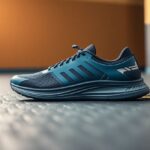
Delve into the revolutionary advancements in running footwear technology that have redefined performance optimisation for endurance athletes globally.
The realm of performance optimisation in endurance running has experienced a significant transformation thanks to advanced footwear technology, granting athletes unparalleled opportunities to elevate their athletic capabilities. You will learn about how innovative shoe designs can significantly lower your metabolic expenditure and enhance running economy. With the incorporation of Carbon fibre plates and groundbreaking midsole materials, these shoes deliver exceptional energy return mechanisms that can potentially reduce your oxygen consumption by as much as 4%. Whether you are a professional athlete or an avid amateur, comprehending these biomechanical advancements will empower you to make informed choices regarding your running equipment and enhance your race performance.
 Continue reading to explore the intricate mechanics of running footwear that promise to elevate your performance:
Continue reading to explore the intricate mechanics of running footwear that promise to elevate your performance:
Maximising Energy Return Mechanisms in Cutting-Edge Running Shoes
The technology behind advanced running shoes employs intricate biomechanical principles that significantly improve energy transfer during movement. Innovative design elements, working in unison, effectively minimise metabolic expenditure, crafting a sophisticated system that enhances running efficiency through meticulous material engineering and tailored geometric configurations. By concentrating on the mechanics of energy return, these shoes provide runners with a notable advantage in both performance and stamina, facilitating longer runs with diminished fatigue.
Unpacking the Curvature Dynamics of Carbon Fibre Plates
Carbon fibre plates utilise precise geometric engineering to channel kinetic energy effectively during running. Optimal curvature angles ranging from 12° to 15° allow for maximum energy storage and return, with finite element modelling showing energy return efficiency of up to 93% in prototype designs. These specially engineered plates create a spring-like effect that diminishes muscular effort during toe-off phases, enabling runners to conserve energy over extended distances, thereby enhancing both endurance and overall performance.
Evaluating TPU versus EVA in Midsole Innovations for Superior Performance
Material selection plays a pivotal role in determining shoe performance, with thermoplastic polyurethane (TPU) emerging as a superior choice for midsole technology. In-depth comparative analysis highlights TPU’s significant advantages in energy return and impact absorption, providing runners with improved biomechanical efficiency across various running conditions. The decision between TPU and EVA foam is crucial for athletes aiming to optimise their performance while minimising injury risks during both training and competition.
| Energy Return | 18% higher in TPU |
| Oxygen Consumption Reduction | 2.4% lower with TPU |
A thorough investigation of midsole materials reveals intricate performance characteristics. TPU exhibits superior resilience when compared to traditional EVA foam, maintaining consistent mechanical properties over thousands of compression cycles. Runners benefit from more reliable energy return, reduced fatigue, and enhanced long-distance performance due to advancements in material science, which can profoundly influence their overall training outcomes and competition results.
| Impact Absorption | TPU absorbs 37% more force |
| Rebound Elasticity | 89% maintained across 50,000 cycles |
 Explore further as we examine the effects of advanced footwear technology on metabolic efficiency:
Explore further as we examine the effects of advanced footwear technology on metabolic efficiency:
Identifying Metabolic Efficiency: The Beneficiaries of Advanced Footwear
Advanced footwear technology does not offer the same benefits to all runners. Gains in metabolic efficiency differ markedly among various demographic groups, influenced by factors such as gender, age, and individual biomechanics, which are crucial in enhancing performance. Researchers have identified intricate patterns of metabolic response, indicating that the advantages of super shoes extend beyond mere performance metrics to include complex physiological adaptations that are unique to each runner’s biomechanical profile.
Investigating Gender-Specific Performance Enhancements in Running
Female runners demonstrate 3.2% improvement in metabolic power, as opposed to 4.2% in males, indicating sophisticated neuromuscular adaptations. Data on pelvic kinematics shows a 14% greater reduction in hip adduction angle in females using advanced footwear, which may elucidate the subtle variations in metabolic gains between genders. Acknowledging these differences can aid in tailoring training regimens and footwear selections to maximise performance benefits for each gender.
Understanding Age-Related Advantages and Endurance Performance in Older Runners
Masters athletes aged 40 and above exhibit 2.8% greater reduction in oxygen cost when utilising super shoes, likely compensating for decreased tendon elasticity. Analysis of tibial loading reveals a 12% cumulative stress reduction per kilometre in older runners, suggesting potential benefits in injury prevention and performance sustainability. These findings underscore the significance of advanced footwear technology in prolonging the competitive lifespan of senior athletes.
The advantages of advanced footwear technology related to age extend well beyond basic performance metrics. Biomechanical studies indicate that older runners experience more significant adaptations due to compensatory mechanisms. Reduced tendon stiffness and modified muscle recruitment patterns interact with shoe technology to forge a unique performance enhancement profile. Specifically, the energy return mechanism of the carbon plate appears to counteract age-related biomechanical inefficiencies, potentially extending the competitive running careers of older athletes by alleviating the physiological constraints typically associated with aging.
Continue reading to discover more about the implications of advanced footwear technology on injury risks:
Evaluating the Impact of Running Footwear on Injury Risks
The introduction of advanced footwear technology brings forth intricate biomechanical interactions that necessitate a nuanced examination of potential injury risks. Runners must carefully weigh the trade-offs between performance enhancement and physiological adaptation. Longitudinal studies indicate subtle yet significant alterations in muscular recruitment patterns, joint loading, and proprioceptive feedback when transitioning to high-performance running shoes, highlighting the necessity for a balanced approach to training and recovery.
Injury Analysis: The Trade-Offs of Enhanced Performance
Biomechanical research reveals a 9% increase in Achilles tendon strain rates among users of super shoes during high-intensity training. Plantar pressure mapping indicates a 22% increase in forefoot loading compared to traditional trainers, particularly when navigating challenging terrains such as downhill running. These findings imply that while metabolic efficiency may improve, runners need to implement targeted strength and adaptation protocols to mitigate potential injury risks and safeguard long-term athletic health.
Adapting Training Protocols for Optimal Gait Adjustments
Your biomechanical response to advanced footwear necessitates strategic alterations in your training regimen. Gait retraining becomes essential to optimise the unique energy return mechanisms of carbon-plated shoes. Runners should concentrate on developing neuromuscular patterns that align with the shoe’s biomechanical design, potentially reducing injury risk while maximising performance benefits.
Comprehensive strategies for gait adaptation involve multifaceted approaches to seamlessly integrate advanced footwear technology into training. Biomechanical analysis indicates that runners typically require approximately 6-8 weeks of progressive training to fully adapt to the distinctive mechanical properties of super shoes. This adaptation period should incorporate targeted eccentric strength training, modified interval training techniques, and careful monitoring of lower limb biomechanics. Professional athletes and serious runners can greatly benefit from periodic 3D gait analysis to track subtle changes in movement patterns, ensuring optimal integration of advanced footwear technology with individual biomechanical characteristics.
 Explore the future of footwear technology and its implications for runners:
Explore the future of footwear technology and its implications for runners:
Anticipating Future Innovations in Running Footwear Technology
Emerging technologies are set to revolutionise running shoe design, pushing the limits of biomechanical efficiency and performance optimisation. Cutting-edge research is focused on personalised solutions that adapt to each runner's biomechanics, utilising advanced materials, computational modelling, and integrated sensor technologies to develop a new generation of intelligent footwear tailored for elite athletes.
Transforming Footwear Design with 3D Printed Midsoles
Optimisation algorithms for lattice structures now allow for precise variations in regional stiffness that correspond with individual foot pressure patterns. Prototype testing has revealed a 5.1% increase in metabolic savings compared to standard mass-produced models, with computational design facilitating unprecedented customisation of midsole geometries to enhance energy return and minimise biomechanical stress. This innovative approach ensures each runner achieves optimal performance tailored to their unique physical attributes.
Integrating Smart Technology for Enhanced Performance Monitoring
New sensor technologies are transforming running shoes into advanced performance tracking devices. Real-time ground reaction force feedback systems have the potential to reduce oxygen costs by 1.9% through micro-adjustments in cadence, providing runners with immediate biomechanical insights during both training and competition. These innovations are essential for athletes striving to refine their technique and performance metrics.
Advanced sensor integration signifies a remarkable advancement in performance monitoring technology. Multi-axis accelerometers, pressure-sensitive matrices, and embedded microprocessors now capture complex biomechanical data with exceptional precision. These smart systems can analyse gait mechanics, impact forces, and energy expenditure in real-time, furnishing runners with detailed insights into their movement patterns. Machine learning algorithms can now anticipate potential injury risks, optimise training loads, and suggest personalised technique modifications based on comprehensive movement analysis, thus transforming running shoes from passive equipment into proactive performance optimisation tools.
Finally, gain a comprehensive understanding of the transformative landscape of advanced footwear technology in endurance running:
Welcoming the Future of Advanced Footwear Technology
In summary, you have explored the transformative landscape of advanced footwear technology in endurance running. Your knowledge now encompasses how innovative design features such as carbon plates and high-performance midsole materials can significantly lower metabolic costs while enhancing running efficiency. By leveraging scientific insights, you can appreciate that these shoes offer more than just marginal improvements—they signify a paradigm shift in athletic performance. Your investment in such technology could potentially lead to improved running economy, reduced energy expenditure, and optimised biomechanical responses across a diverse range of athletic demographics.
The Article Biomechanical Efficiency of Advanced Footwear Technology: Metabolic Cost Reduction and Performance Enhancement in Endurance Running appeared first on My Shoes Finder.
The Article Biomechanical Efficiency in Advanced Footwear for Runners Was Found On https://limitsofstrategy.com







